Stamping
From DDL Wiki
| Line 21: | Line 21: | ||
''Air bending''<br /> | ''Air bending''<br /> | ||
The process by which sheet metal is plastically deformed to a desired angle.<br /> | The process by which sheet metal is plastically deformed to a desired angle.<br /> | ||
| - | [[Image:BendingProcess.gif]] | + | [[Image:BendingProcess.gif]]<br /> |
''Bottoming''<br /> | ''Bottoming''<br /> | ||
The same process as air bending, except that the workpiece reaches the bottom of the die.<br /> | The same process as air bending, except that the workpiece reaches the bottom of the die.<br /> | ||
| Line 37: | Line 37: | ||
'''<big>Capabilities</big>'''<br /> | '''<big>Capabilities</big>'''<br /> | ||
MATERIALS<br /> | MATERIALS<br /> | ||
| - | '' | + | ''More Common''<br /> |
Aluminum (T1, T2, All alloys)<br /> | Aluminum (T1, T2, All alloys)<br /> | ||
Steel (Cold/Hot rolled, Galvanized, All alloys)<br /> | Steel (Cold/Hot rolled, Galvanized, All alloys)<br /> | ||
| Line 51: | Line 51: | ||
<br /> | <br /> | ||
SHAPES<br /> | SHAPES<br /> | ||
| + | As you can see from the above processes both simple and complex shapes can be made by combinging different stamping operations. Some basic shapes include cups by drawing, flanges by bending, almost any 2-D shape by blanking, and a variety of hole shapes by punching.<br /> | ||
| + | <br /> | ||
| + | PRECISION<br /> | ||
| + | |||
'''<big>Use</big>'''<br /> | '''<big>Use</big>'''<br /> | ||
| - | + | Stamping is generally used to create simple or complex shapes at high production rates.<br /> | |
| - | + | COMMON EXAMPLES<br /> | |
| + | Aluminum soda cans<br /> | ||
| + | Automobile body panels<br /> | ||
| + | Metal desks<br /> | ||
| + | Hubcaps<br /> | ||
| + | Kitchen utensils<br /> | ||
| + | Plumbing fittings<br /> | ||
| + | <br /> | ||
| + | DESIGN CONSIDERATIONS | ||
| + | ''Blank design'' - Material scrap is a major concern of stamping, so it is important that blanks be designed so that they can be easily nested in order to reduce scrap.<br /> | ||
| + | ''Bending'' - Bending creates large distortions of the stress concentration within the sheet metal. At times these concentrations can become large enough to create wrinkling, buckling or even fracture. One common practice to reduce these effects is the incorporation of carefully located notches in the design of the part. These notches can help avoid tearing and wrinkling in right angle bending operations. It is also important to avoid placing holes too close to a bend, since holes already create areas of higher stress concentration.<br /> | ||
| + | ''Progressive die operations'' - Tooling costs can become somewhat expensive in stamping operations, so it is important to design the part with as few features as possible, or features that require few stamping stations. If two features are placed too closely together, there might be to small of a clearance for simultaneous punches, thus adding unnecessary tooling costs to the process.<br /> | ||
| + | ''Springback'' - Plastic deformation of a material is always followed by elastic recovery once the load causing the deformation is removed. A common fix of this phenomenon is simply overbending the part, so it springs back to the desired angle.<br /> | ||
'''<big>Cost</big>'''<br /> | '''<big>Cost</big>'''<br /> | ||
Revision as of 02:53, 12 February 2007
Process
Stamping is the manufacturing process by which sheet metal is deformed via a die and punch into a desired shape. It is a very versatile process capable of many different form operations such as piercing, drawing, bending, etc. Progressive-die operations is when a stamped shape require a combination of these various operations or even just multiple stations of the same operation.
PIERCING
Blanking
The process by which a punch and die apply pressure to sheet metal to shear it and obtain a desired shape (blank) that is removed from the sheet which is now considered scrap.
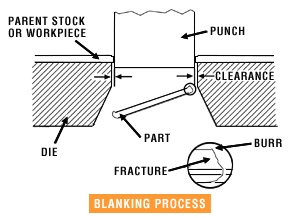
Punching
The same process as blanking, except that removed material is scrap, and the remaining sheet is the workpiece.
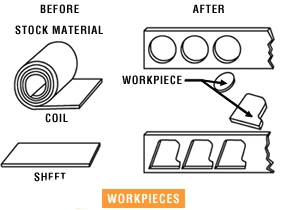
DRAWING
Deep drawing
The process by which a sheet metal blank is formed into a cylindrical or box-shaped part by the punch pressing the blank into the die cavity.
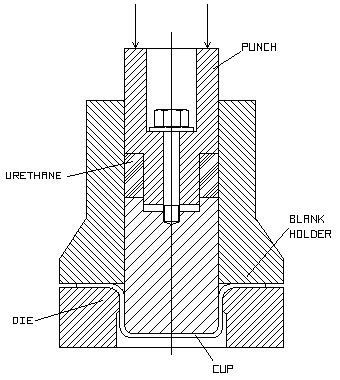
Ironing
The same process as deep drawing, except that the die cavity has less clearance forcing the resulting cup to have a constant wall thickness.
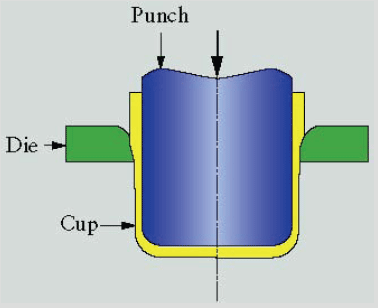
BENDING
Air bending
The process by which sheet metal is plastically deformed to a desired angle.
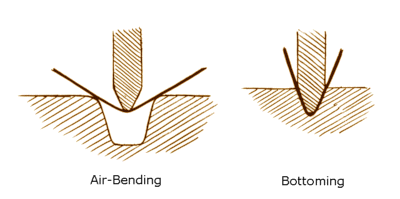
Bottoming
The same process as air bending, except that the workpiece reaches the bottom of the die.
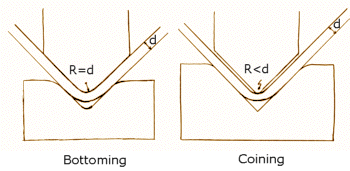
Coining
The same process as bottoming, except that the punch tip penetrates the neutral axis of the material.
Flanging
Another variation of bending in which the edges of the sheet metal are bent to create a flange.
BULGING
Embossing
The process of forming shallow shapes, like letters, numbers or designs on sheet metal.
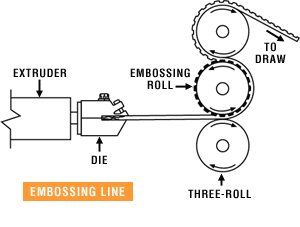
Capabilities
MATERIALS
More Common
Aluminum (T1, T2, All alloys)
Steel (Cold/Hot rolled, Galvanized, All alloys)
Less Common
Brass
Copper
Titanium
Zinc
SIZES
Sheet thickness typically varies from .005" to .075"
Sheet widths are typically no greater than 4 feet.
SHAPES
As you can see from the above processes both simple and complex shapes can be made by combinging different stamping operations. Some basic shapes include cups by drawing, flanges by bending, almost any 2-D shape by blanking, and a variety of hole shapes by punching.
PRECISION
Use
Stamping is generally used to create simple or complex shapes at high production rates.
COMMON EXAMPLES
Aluminum soda cans
Automobile body panels
Metal desks
Hubcaps
Kitchen utensils
Plumbing fittings
DESIGN CONSIDERATIONS
Blank design - Material scrap is a major concern of stamping, so it is important that blanks be designed so that they can be easily nested in order to reduce scrap.
Bending - Bending creates large distortions of the stress concentration within the sheet metal. At times these concentrations can become large enough to create wrinkling, buckling or even fracture. One common practice to reduce these effects is the incorporation of carefully located notches in the design of the part. These notches can help avoid tearing and wrinkling in right angle bending operations. It is also important to avoid placing holes too close to a bend, since holes already create areas of higher stress concentration.
Progressive die operations - Tooling costs can become somewhat expensive in stamping operations, so it is important to design the part with as few features as possible, or features that require few stamping stations. If two features are placed too closely together, there might be to small of a clearance for simultaneous punches, thus adding unnecessary tooling costs to the process.
Springback - Plastic deformation of a material is always followed by elastic recovery once the load causing the deformation is removed. A common fix of this phenomenon is simply overbending the part, so it springs back to the desired angle.
Cost
High tooling and equipment costs
Low labor costs
References
1. http://en.wikipedia.org/wiki/Stamping_%28metalworking%29
2. http://www.beststampings.com/index.htm
3. http://www.engineersedge.com/manufacturing/metal_stamping.htm
4. http://www.mfgquote.com/process_metal_stamping.cfm
5. http://www.visionsenterprises.com/mastertool/definitions.htm
